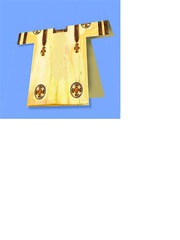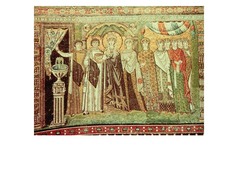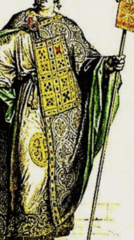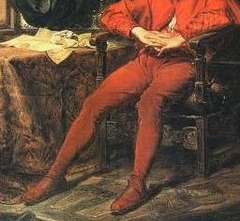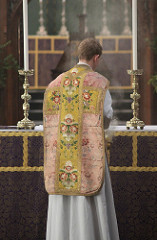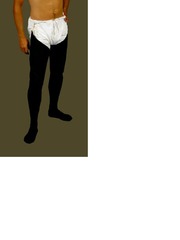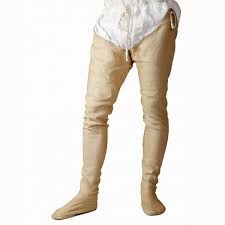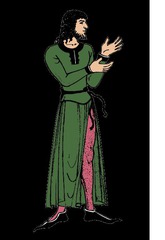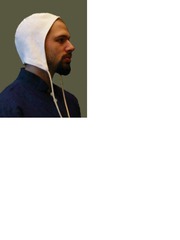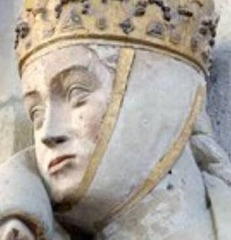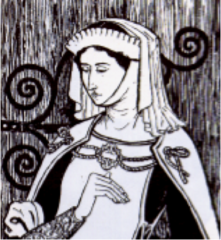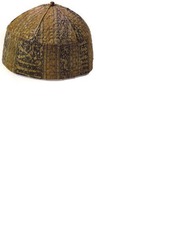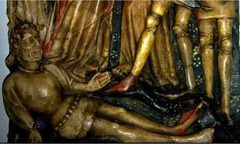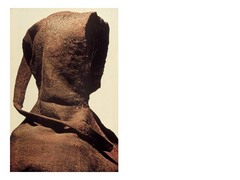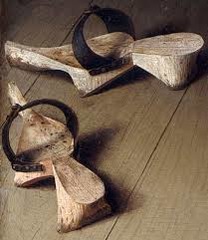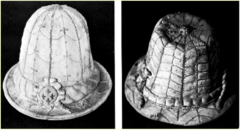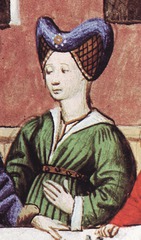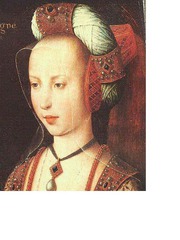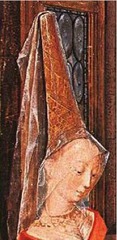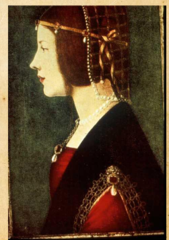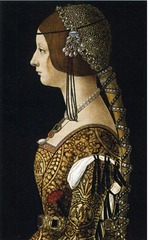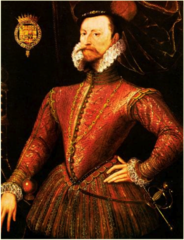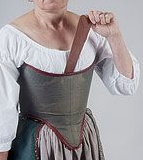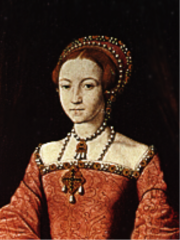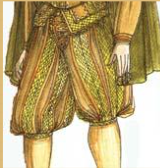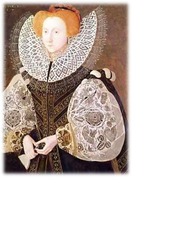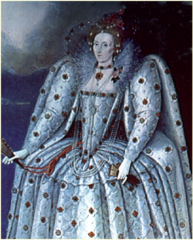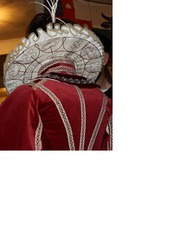Constantinople
established by Constantine in 330 CE
Oikos
preservation and honor of the family
sericulture
production of silk from silkworms
segmentae
patches of embellishment
clavi
purple bands that denote royalty or high status; ornate from oriental influence
tablion
rectangular purple patch
paludamentum
cloak worn over tunic to denote status; formerly worn by military officials
hosa
leggings under tunic
Dalmatic
long tunic worn by women
tunica alba (Alb)
white undergarment worn by priest
chasuble
round cape over head worn by clergy
gaiters
strips of linen or leather wrapped around leg to hold hose in place
chemise
undershirt/undertunic
feudalism
political system based on land ownership; lords employ serfs and peasants to work the land
vassal class
ruled over the divided lands in feudalism
sumptuary laws
lower class cannot wear noble costume
braies
undergarment, linen, belted
mantle
cloak, either fastened at front or pulled over the head
chausses
hose, attached with garter to braies
bliaut
tailored tunic for upper class; excess fabric, decorative, pleats
coif
cap; night cap for older people or intellectuals
pigache
pointed shoes with curled up toe; longer toe=higher status; borrowed from Turkey or Count Faulk’s bunions
chainse
loose fitting white house coat
barbette
holds toque in place under chin
wimple
extra scarf down back of toque to cover hair
cyclas
sleeveless surcote (knights)
garnache
outerwear with capsleeves, long, pulled over head, furlined collar, hood
herigault
outerwear with slit for arms, hood, cape
calotte
brimless hat, covered basically the whole head
pourpoint
long shirt, semi-full skirt, buttons all down front; tailored and fit to the body, borrowed from the knights, quilted material
points
laces/ garters connect chausses to doublet
cotehardie
extension of pourpoint, belted at hips
tippet/lappet
extra fabric hanging from elbow of cotehardie
houppelande
outer-tunic fitted in shoulders, no front closure, massive sleeves
dagging
decorative cuts in long sleeves
poulaine / crackow
shoe with pointed toe, not curled up
liripipe
long extension off hood
plastron
vest over top of dress, reinforced, padded, broaches down front
ceruse
mixture of vinegar and lead used to whiten skin
pattens
wooden platforms to protect shoes
sugar loaf hat
looks like a loaf of bread
huque
like the cyclas, lined with fur, worn over arm, originated with knights
archer’s hat
Robin Hood hat
caul
hairnet worn as a decorative hair covering which was pinned to a hat
bourrelet
large circular or oval roll of material that fit around the crown
hennin
high, conical hat usually with a veil affixed to the top; typical “princess” hat
particoloring
2 different colors on hose, coat of arms
working class Renaissance gown
rounded neckline, close bodice, visible camicia, hem at floor, tubular sleeves, belt above natural waistline
aristocratic Renaissance gown
v-neck, sleeveless surcote, side laces, slashed sleeve/open-seams, petticoat visible at front and sleeves
working class Renaissance gown
layered, pushed up sleeves of surcote exposing petticoat
ferroniere
thin headband across forehead; hid sores on face due to syphilis; Madame Ferroniere
Juliet cap
Renaissance headwear with lace knit on back of head
slashing
slits in thighs of hose exposing lining underneath; from war with Swiss vs French
peascod belly doublet
made chest look bigger
ruff collar
heavily starched linen like an accordion
pumpkin/melon hose
hose puffed at the top with drawstrings at thighs
venetians
upper stock, baggy full at thigh, tight band at knee
chopine
shoes with platform to give height for gowns
farthingale
triangular petticoat
French farthingale
petticoat that creates wide hips
coral necklace
used for teething, believed to have curing powers; girls would wear at their wedding; symbol of youth, health, immortality
Catherine of Aragon
wife of Henry VIII, Spanish, very Catholic
Anne Boleyn
wife of Henry VIII, had Elizabeth I
Jane Seymour
wife of Henry VIII, had Edward VI
Mary I
bloody Mary, Protestant persecution
chamarre
kneelength jacket, broad shoulders, fur collar, dropped shoulder
stomacher
contrasting fabric inserted in patlock
duckbill shoes
shoes with slashing and square-toed
partlet
dickey, cover chest
busk
metal rod for erect posture
French hood
crescent shaped hood
German style hood
gold netting over hair
slops
upperstocks with wide legs, originated with navy
bolster
in lieu of farthingale, roll around the waist
rebato collar
collar- circular piece of lace, closed at front
medici collar
collar- lace, stands up, comes down side of bodice, open front
whisk collar
collar- flat lace over tops of shoulders
conch
cape, sheer fabric supported by wire, “Queen of Hearts”
supportasse
supports collar
inverted v-ruff collar
collar- accordion but open in front like medici collar
doublet
shorter version of pourpoint
This essay was written by a fellow student. You may use it as a guide or sample for
writing your own paper, but remember to
cite it correctly . Don’t
submit it as your own as it will be considered plagiarism.
Need custom essay sample written special for your assignment?
Choose skilled expert on your subject and get original paper with free plagiarism report
Order
custom paper
Without paying upfront

